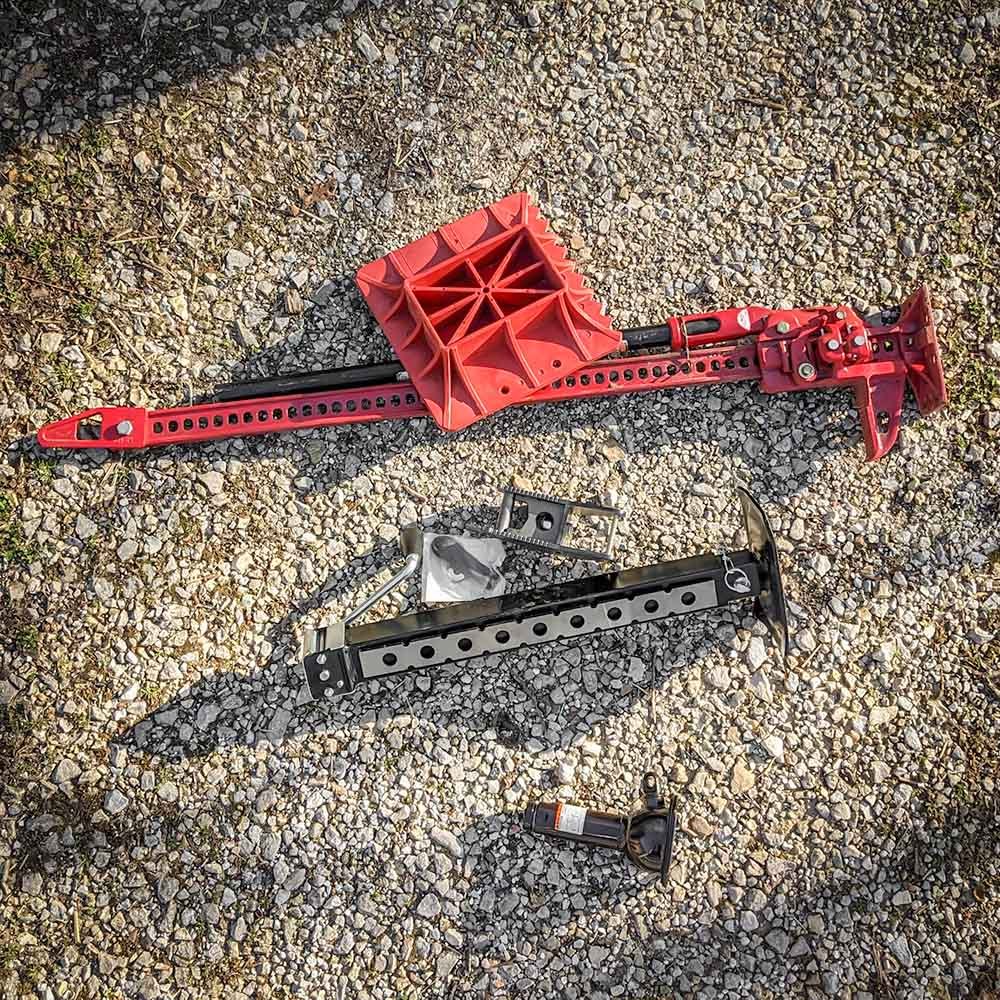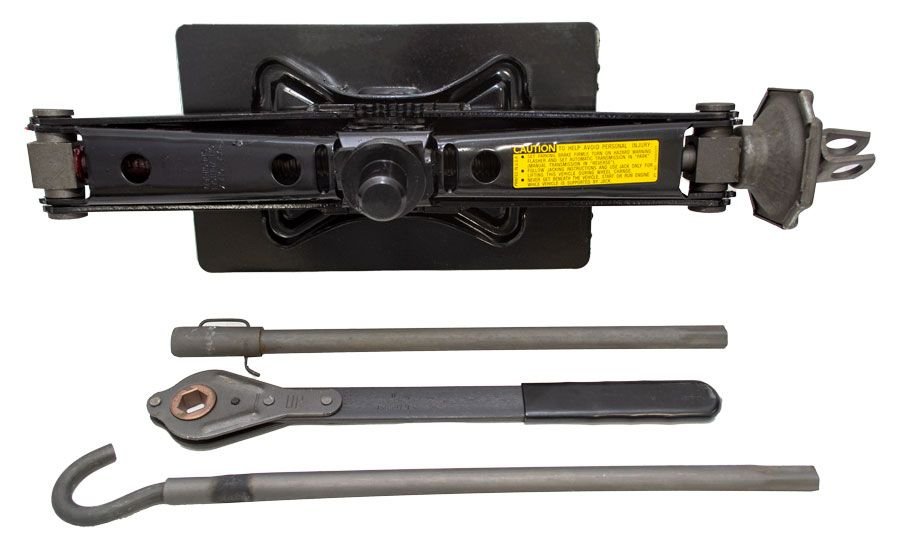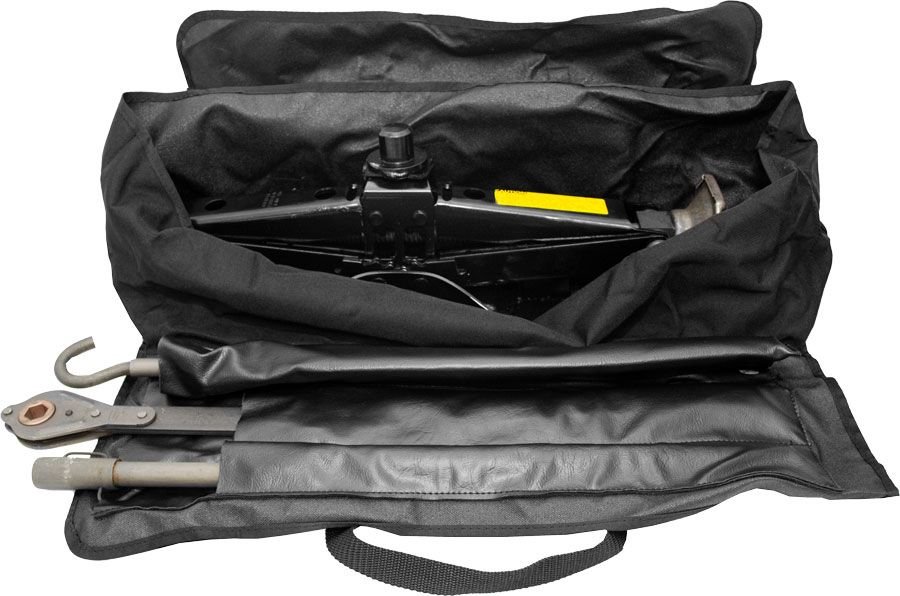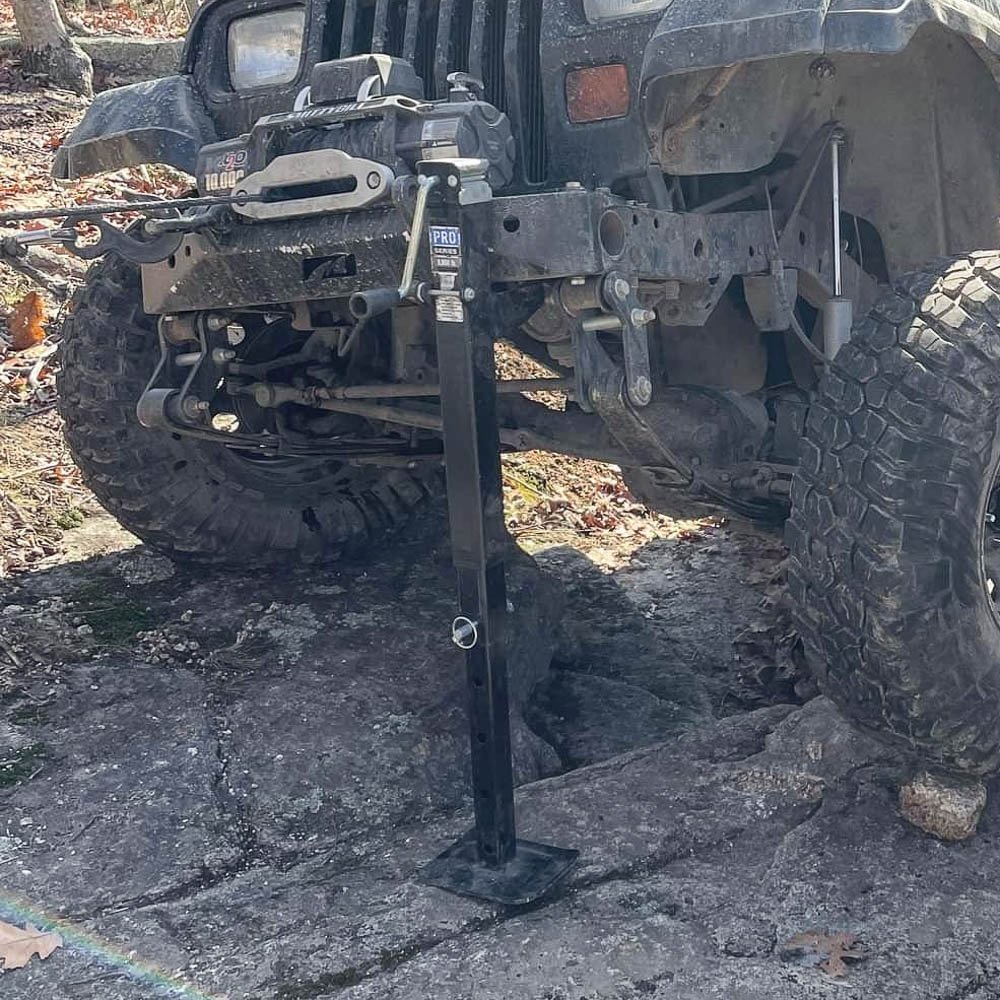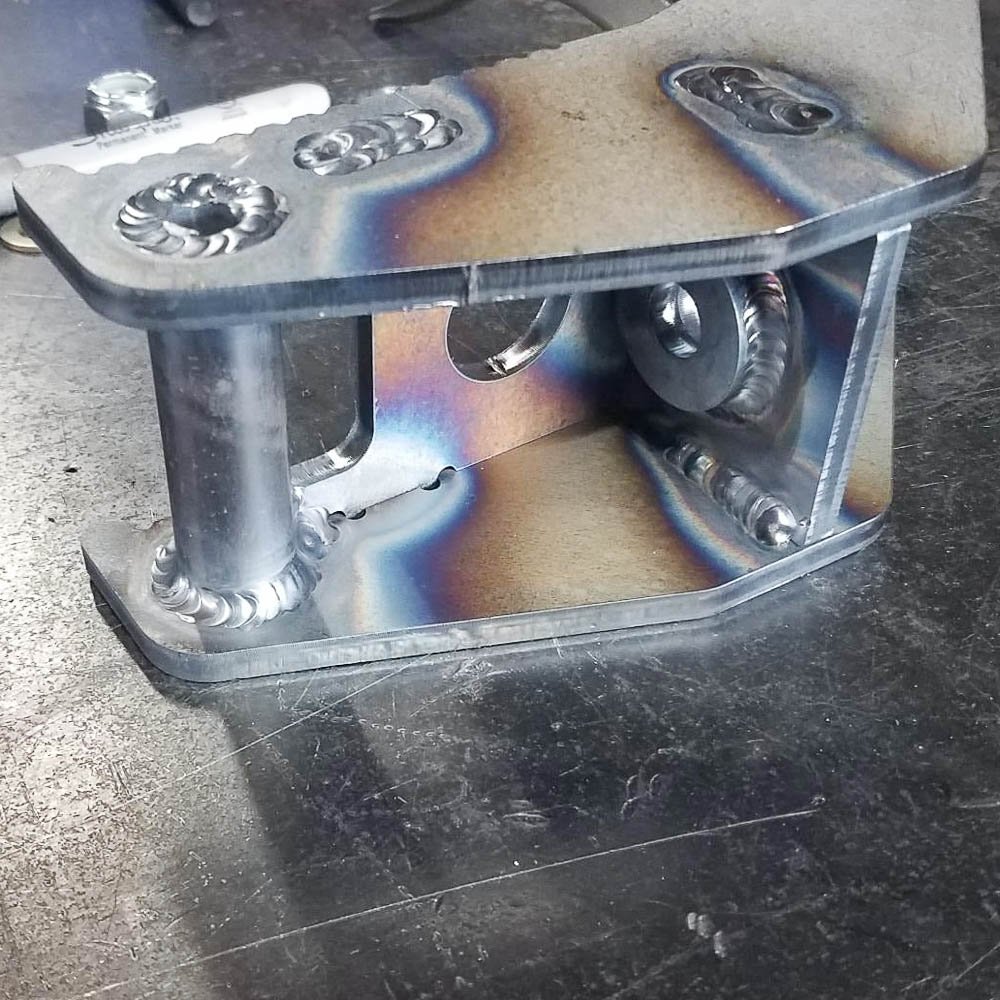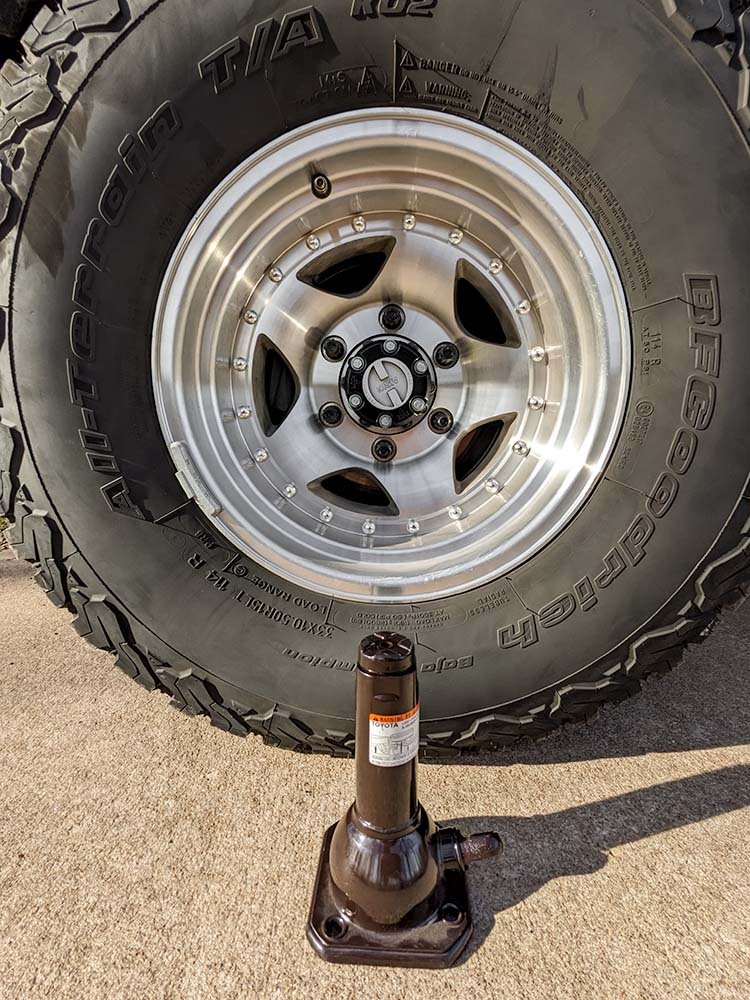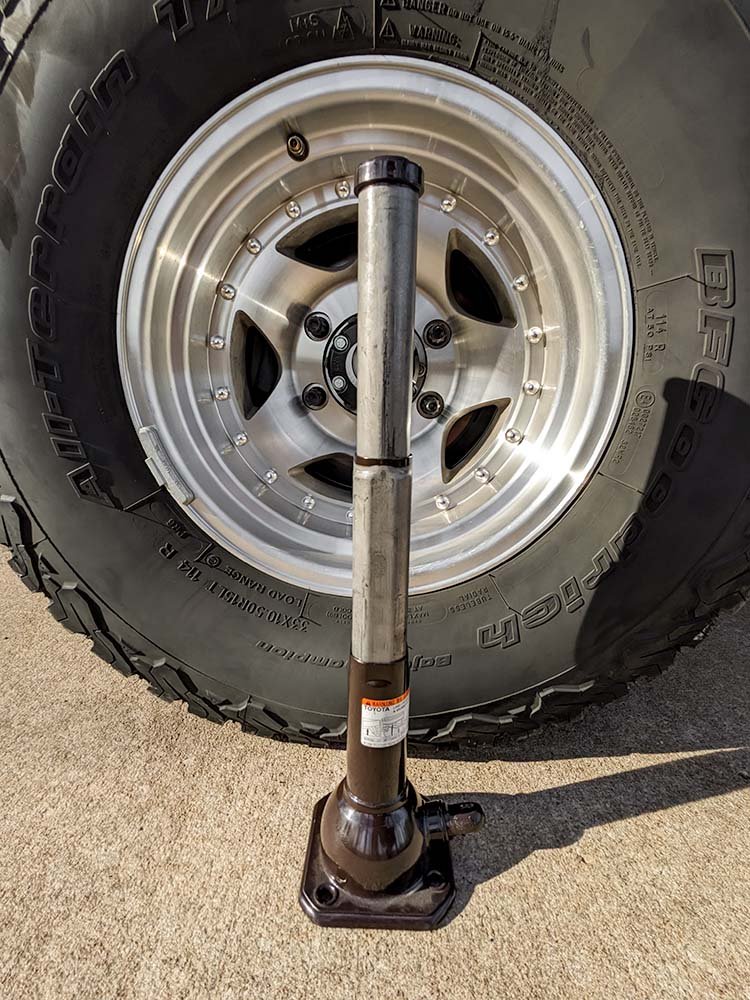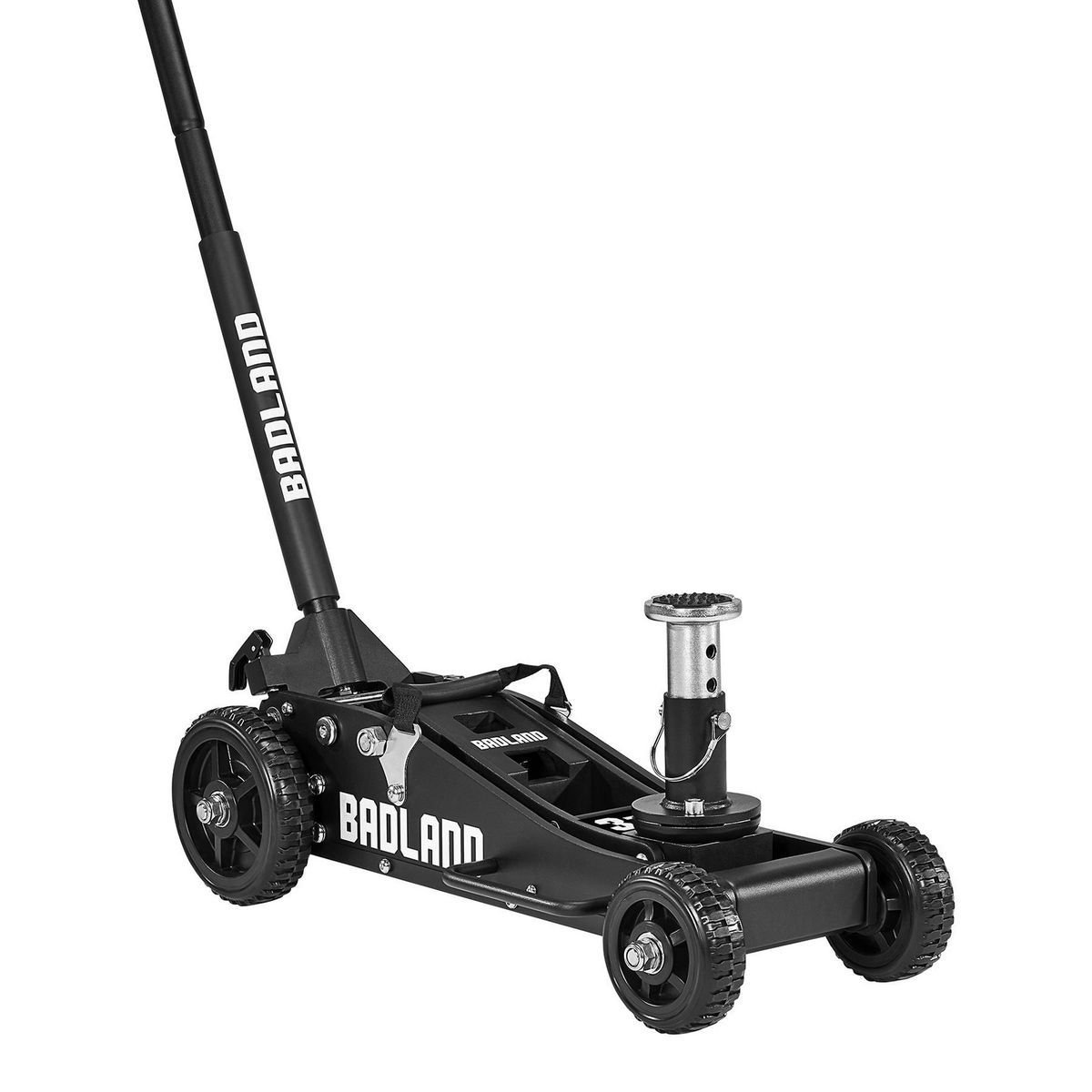The Complete Guide to Off Road Jacks
An off road jack is an absolutely essential piece of overlanding gear for your 4WD vehicle. Often the best solution, if you intend to travel off road in a variety of terrain conditions, is to carry a combination of off road jacks so you’re equipped.
In this post we’ll cover the five main categories of off road 4x4 jacks, the pros and cons of each, and we’ll help you choose the best off road jacks for whatever your adventure may throw at you.
What to Consider When Choosing an Off Road Jack
There are several factors to consider when selecting the right off road jack for your 4x4 or overland vehicle.
Capacity
An off road jack’s capacity is the amount of weight the jack is capable of safely lifting. This is typically stated as a tonnage rating (e.g. 4 ton), but may also be listed in pounds. Determining the Gross Vehicle Weight (GVW) of your fully-laden vehicle (you can do this at any certified CAT scale) can give you a good basis for selecting a properly rated off road jack.
Once you know your vehicle’s GVW, you can select an off road jack with a tonnage rating appropriate for supporting this weight.
Keep in mind that the jack will likely never lift the entirety of your vehicle’s weight, with some weight generally resting on the tires, and if you’re using multiple jacks the weight will be distributed between them as well.
Lift Range / Travel
The range or travel of an off road jack’s lift refers to the height (minimum to maximum) the jack can effectively lift at its rated capacity. Generally, the wider the lift range the more versatile the jack will be for lifted 4x4 vehicles as well as a variety of off road terrain conditions.
Size & Weight
Space and weight are typically at a premium when traveling off road or overlanding, so be sure to factor in a jack’s size and weight to ensure it fits in an accessible location in your 4x4 vehicle - OR that you have a means of mounting it to the outside of your vehicle.
Terrain
Certain off road jacks are better suited to certain types of terrain conditions (e.g. sand, mud, snow, rock, etc.), so consider the type of off road driving you may encounter and ensure you have a jack that’s up to the trail conditions.
Your Vehicle’s Limitations
Not all off road jacks work with all vehicles. Some vehicles, especially stock unmodified vehicles, do not have suitable jack points for some off road jacks (like the Hi-Lift). Others may have lower ground clearance, which may require an off road jack with a very low minimum lift range.
Alternatively, if you have installed an aftermarket suspension lift or larger tires you may need an off road jack with a taller lift range.
It’s also a good idea to review your vehicle’s manual to determine the factory jack points and select an off road jack that can safely reach and lift at these locations.
Cost
While the importance of cost varies person-to-person, it’s certainly a factor in any decision. When it comes to recovery gear and equipment we generally ascribe to the buy-once-cry-once motto, but you don’t have to break the bank to have a safe and reliable off road jack solution.
*(This post contains affiliate links. This means we may receive a small commission, at no additional cost to you, if you make a purchase through a link. See our full disclosure.)
THe Five Categories of Off Road Jacks
There are five categories that most off road jacks fall into: scissor jacks, recovery jacks (farm jacks), bottle jacks, floor jacks, and air jacks/exhaust jacks. Below we’ll outline the pros and cons of each type, and highlight some of the best off road jacks in each category.
1. 4x4 Scissor Jacks
Scissor jacks are the most commonly supplied type of jack by vehicle manufacturers, so odds are favorable that you already have one tucked away in your rig! They use a mechanical screw-driven lifting mechanism to lift your vehicle, and can provide a great deal of lift for a relatively compact jack.
PROS
Relatively compact
Wide travel range (typically from as low as 4 inches up to 17+ inches)
Reliable mechanical screw-drive, won’t leak like hydraulic jacks
Low maintenance
Fine lift adjustment with a smooth lift and lower
Fairly light-weight
Fast (**if used in conjunction with an ½” adapter* and battery operated impact driver)
Safer than a farm jack
CONS
Can be unstable at the higher end of their lifting range
Need to be perfectly level for safe lifting
Slow to operate manually (without power tool assistance)
Screw drive mechanism is exposed to dirt and debris
Scissor jacks with taller lift range (20-30inch lift height) are large and cumbersome to store
Not suitable for soft terrain conditions such as sand, snow, or mud
Best Off Road Scissor Jack
Because of their limitations, there are not a lot of off-road specific scissor jacks on the market to choose from. If you’re looking to upgrade from your stock scissor jack, the HMMWV 3.5ton scissor jack is an excellent option.
HMMWV 3.5 Ton Scissor Jack
Capacity: 3.5 ton / 7000lbs
Lift Range: 6 - 20 inches
Weight: 25lbs
Collapsed Size: ≅ 24” x 8” x 8”
These military style off road scissor jacks were made for the Humvee with a wider (7in. by 12in.) base plate for greater stability and, when combined with Agile Offroad’s Reversible Adapter Plate, allows for safe lifting from your 4x4 vehicle’s axle or frame positions in a variety of off road terrains.
(TIP: you can often find good deals on used or new-old-stock HMMWV scissor jacks at military surplus stores, on eBay, and other online marketplaces)
At a minimum, you’ll want to carry a jack stabilizer base* for your stock vehicle scissor jack to make it more stable and useful off road, and ensure that your stock jack still reaches the factory jack points on your vehicle if you’ve added a lift or upgraded suspension, or installed larger tires on your 4x4.
2. Recovery Jacks (Farm Jacks | Hi-Lift Jacks | Beam Jacks)
Off road recovery jacks (also known as perimeter jacks, beam jacks, farm jacks, or hi-lift jacks) have a much taller lifting range than other off road jacks and lift from fixed jack points around the perimeter of your off road vehicle (provided it has them).
As such, they don’t work well with stock vehicle jack points and typically require aftermarket off road bumpers and/or rock sliders that provide these additional frame-connected jacking points.
PROS
Tallest lifting capability of any off-road jack (from as low as 5” to 50”+ depending on the model)
Fast and fairly simple to use
Do not require space/placement underneath the vehicle
Versatile
Work in a variety of terrain surfaces (especially when combined with a wider off road jack base plate)
CONS
Bulky to store
Heavy (average around 30lbs)
Some, like the most common Hi-lift, are affected by dirt and the elements - requiring routine maintenance, cleaning, and greasing especially if mounted on the exterior of your off road vehicle
Not designed for use with most stock vehicles
In order to change a tire, the chassis of the vehicle must be jacked up high enough to completely uncompress the suspension so that the axle and tire will then lift off the ground
More Dangerous - due to the heights of lifting required, they’re generally more unstable than other off road jacks.
Due to its long handled lever-actuating design, the HI-Lift / Farm jack must be treated with extreme caution while in use. We highly recommend reviewing Bruce Elfstrom’s Hi-Lift write up prior to carrying a Hi-Lift as your off road jack, as well as getting hands-on training with others in your local off road or overland community or from a certified I4WDTA trainer.
Best Off Road Recovery Jacks
The Hi-Lift jack’s design has been in use for over 100 years and in that time has become the de facto off road recovery jack of off roaders and overlanders. However, there are some alternative designs that have recently come to the market - including ARB’s “Jack” hydraulic off road recovery jack and the semi-DIY screw-drive “Tauler Jack” kit by Brennan’s Garage - that improve on some of the safety shortcomings of the Hi-lift’s traditional farm jack design.
Hi-Lift Xtreme 48in. Recovery Jack
Capacity: 2.5 ton / 5000lbs rated lift (tested to 7000lbs)
Lift Range: 4.5 - 38.63 inches
Weight: 33lbs
Collapsed Size: ≅ 50” x 8” x 5”
The Hi-Lift Xtreme is a traditional mechanical-style off road farm jack design with the addition of a winch/clamp/spreader with 7/8in. shackle and 3/8in chain connections that make it the most versatile off road jack on the market.
However the winching capability of the Hi-Lift is often overstated, and most will be better served by carrying a basic 5 ton come along* that can perform the same function more safely and efficiently, if your vehicle is not equipped with a dedicated off road 4x4 winch.
If you decide the hi-lift is right for you, we highly recommend the Lift-Mate* accessory that allows you to more easily lift a wheel for positioning traction aids or repair, as well as the Hi-Lift Off Road Base* for added support in soft terrain conditions.
The Tauler Jack
Capacity: 2.5 ton / 5000lbs lift
Lift Range: 6 - 50 inches
Weight: 25.5lbs
Collapsed Size: ≅ 25” x 7” x 9”
The Tauler Jack is a semi-DIY off road jack kit that is the brainchild of Brennan’s Garage out of Durango, CO. It uses a either a standard 8000lb 2.25” square weld-on side-crank trailer jack* (not included) as the basis, you then weld the supplied adjustable pin strip to the jack body, and weld together the CNC pre-cut jaw and peg system that mates with the pin strip.
While this DIY off road jack isn’t for everyone, it’s a fairly simple assembly for the at-home welder. Plus it creates a 4x4 jack that’s a good deal safer, more compact (by nearly half), and easier to operate than the traditional Hi-Lift jack.
It does, however, lack the ability to winch or to be used as a trail vise. They have recently released an optional Chain Nose adjustable lifting adapter that enables lifting at the wheel and a variety of other locations - similar to the Hi-Lift’s Lift Mate, but more robust and versatile.
The ARB “Jack”
Capacity: 2 ton / 4400lbs rated lift
Lift Range: 6 - 48 inches
Weight: 23lbs
Collapsed Size: ≅ 35” x 8” x 6”
The ARB Jack utilizes a hydraulic system to make lifting smoother and easier than a traditional farm jack, and its seamless release mechanism makes lowering the jack much safer. It uses an adjustable lift foot (similar to the Tauler Jack) that allows for use of the full 48” of lift range (unlike the Hi-Lift).
However, it is one of the priciest off road jacks on the market by a good margin and the ARB Jack doesn’t share the versatility of the Hi-lift’s winching and trail vise capabilities.
Because of the hydraulics, ARB recommends that the Jack not be stored horizontally (to prevent leakage of hydraulic fluid past the seals), this may pose storage issues depending on your application.
3. Off Road Bottle Jacks
Though they lack the versatility of a traditional recovery jack, a bottle jack should always be your first choice in an off road recovery or off road repair situation. It is much easier to use safely, provided you have - or can create - a stable surface for the jack’s base.
PROS
More stable (especially with an additional baseplate)
Steady lifting and lowering is more controlled
Less affected by dirt and the elements, very little maintenance required
Small, compact form factor
Excellent for clearing smaller obstacles using the jack and tip technique
Typically short enough to be placed under your vehicle’s axle, making tire replacements and repairs easier and safer.
Typically higher load rating than other off road jacks
CONS
Less practical for recoveries in soft terrains such as mud and sand
Requires sufficient space for placement underneath the vehicle, sometimes excavation is required to achieve a suitable jack point on the vehicle
Shorter lift height than other off road jacks (typically 20” or less, but the jack itself can be elevated using RV leveling pads or blocks of wood to offset this)
Requires additional baseplate to improve stability
Best Off Road Bottle Jacks
There are a ton of bottle jacks on the market, but finding one with enough lift range for 4x4s and off road recovery can be a bit of a challenge. The three highlighted below are all great options to keep on hand.
SafeJack Off Road Bottle Jack Kit
Capacity: 6ton / 12000lbs
Lift Range: 8 - 36 inches
Weight: 24lbs
Collapsed Size: ≅ 14” x 5” x 8”
The SafeJack off road bottle jack kit uses a combination of sleeves and adapters to add lift range and capability to a standard hydraulic bottle jack.
Alternatively, you can purchase their SafeJack accessories separately and supply your own bottle jack.
The Toyota Mechanical Bottle Jack
Capacity: 1.8ton / 3970lbs
Lift Range: 8 - 19 inches
Weight: 6.3lbs
Collapsed Size: ≅ 8” x 5” x 5”
The Toyota factory bottle jack utilizes a sleeved mechanical lift mechanism that doesn’t suffer from the leakage and maintenance issues common with standard hydraulic bottle jacks.
Most models provide a wide lift range without the need for adapters, though they are more limited in their lifting capacity. You can find deals on them used at salvage yards and online marketplaces, or you can purchase them new from Toyota (Toyota PN# 09111-60131 or 09111-60082 are two options).
CAT 4Ton Off Road Bottle Jack & Jack Stand Combo
Capacity: 4 ton / 8000lbs
Lift Range: 11 - 21 inches
Weight: 22.6lbs
Collapsed Size: ≅ 12.25” x 9.75” x 9.75”
This 4-ton bottle jack combines the lifting ability of a hydraulic bottle jack with the stability and safety of a jack stand. It includes a rubber adapter pad for pinch weld jack points, and its reasonably tall 21” lift height is well suited for a variety of 4x4 vehicles.
It also saves space by not requiring the need to carry separate jack stands, but this convenience comes at the cost of added size and weight.
4. Off Road Floor Jacks
Off road floor jacks are a relatively new entrant to the 4x4 jack market. They combine the ease-of-use and safety of a traditional shop floor jack with larger diameter off road wheels, a full length skid plate, and an adjustable height that’s better suited for lifted off road vehicles.
PROS
Easy to use
High degree of stability
Fast and smooth lifting
CONS
Heavy (generally greater than 50lbs) and bulky to store
Hydraulics always have the potential for seal failures/leakage
Not well suited for mud or snow
Best Off Road Floor Jacks
Though modified floor jacks have been in use in the off road racing scene for decades, consumer models have only been available for the last several years. These models, by Pro Eagle and Harbor Freight respectively, are both excellent options.
Pro Eagle Off Road Jack
Capacity: 2 ton / 4400lbs
Lift Range: 6 - 26 inches (with included 8” adapter)
Weight: 52lbs
Collapsed Size: ≅ 29” x 13” x 6”
Pro Eagle was the first entrant into the off road floor jack market, with a jack that includes an 8” height adapter to provide enough height for lifted vehicles, large diameter wheels, and a full length steel skid plate to keep it stable on sand and gravel.
While they do make a 3 ton model*, we feel it doesn’t offer enough value over the comparable Badlands Off Road Jack by Harbor Freight (discussed more below). This 2 ton Pro Eagle model, however, uses an aluminum construction that makes it a good deal lighter (25lbs!) and more manageable than the competitor’s offering
It’s definitely one of the pricier off road jacks, but if you’re looking for speed and stability it's one of the best.
Harbor Freight Badland Off Road Jack
Capacity: 3 ton / 6600lbs
Lift Range: 6.25 - 29 inches (with included adapter)
Weight: 78lbs
Collapsed Size: ≅ 31.75” x 14.25” x 6.25”
In recent years Harbor Freight’s off road supply offering has really grown to an impressive variety of budget-friendly gear, and the Harbor Freight’s Badland Off Road Floor Jack is no exception.
It includes a similar set of features to the Pro Eagle, and even improves on some aspects like a handle lock detent for easier maneuvering, side handles for easier positioning, and a slightly taller lift height. Though it is 25lbs heavier, unlike the Pro Eagle it meets ASME-PASE safety requirements.
5. Air Jacks And Exhaust Jacks
Air Jacks, also known as exhaust jacks, are useful for off-road vehicle recoveries in soft terrain conditions. The jack’s thick multi-layer rubberized canvas bag is positioned beneath the frame of the vehicle and then utilizes either your vehicle’s exhaust gasses or an air compressor to inflate the bag, thus raising the vehicle up.
PROS
Excellent for recoveries in loose terrains, such as bogs, sand, or mud, due to their wide surface area
Flat profile fits under your vehicle in tighter situations, requiring less digging
Fast
Work well in uneven terrain
CONS
Can be damaged/punctured if used on rough terrain or by a sharp edge on the vehicle (most models include a patch kit)
Requires two people to safely operate
Bulky when stored
Not compatible with vehicles with acute angle or twin exhaust (though you can still inflate with an air compressor)
Dealing with noxious exhaust fumes
Limited lift height (typically around 30” max)
Best Off Road Air Jacks
Most of the exhaust jacks currently on the market, including the original Bushranger X-Jack, are now manufactured in Taiwan, so it really boils down to selecting one that meets your needs and budget. Below are two of the best off road air jacks currently on the market, in order of cost.
ARB Bushranger X-Jack
Capacity: 2 ton / 4400lbs
Lift Range: appx 3 - 31 inches
Weight: 19.8lbs
Collapsed Size: ≅ 24” x 24” x 2.5”
The Bushranger X-Jack is the original off road exhaust jack. It uses a triple layer top with a hard insert core that provides more strength and rigidity, as well as triangular grips on the bottom for added traction.
All-Top Off Road Air Jack
Capacity: 4 ton / 8800lbs
Lift Range: appx 3 - 31 inches
Weight: 15.6lbs
Collapsed Size: ≅ 18” x 18” x 2.5”
The All-Top Off Road exhaust operated air jack is a more budget-friendly exhaust jack.
It has twice the rated capacity of the X-Jack, partly due to its high tenacity 1000D Nylon material with a plasticized PVC coating.
Off Road Jack Accessories
Jack Pad Base Plates - The Reese jack pad* is a great budget-friendly option that has a 7000lb rating and a removable locator for farm jacks.
Off Road Shovel - Sometimes it’s necessary to make some clearance beneath a bogged vehicle by digging out in order to fit the off road jack into position. Check out our guide on How to Choose the Best Off Road Shovel for Overlanding for a list of the top 10 best shovels for off roading.
Wheel Chocks/Blocks - AFA Tooling heavy duty wheel chocks* are a great budget-friendly option for stabilizing your 4x4 prior to using your off road jack.
Jack Stands - these Torin aluminum jack stands* meet ASME requirements and have a removable base that makes them easier to store in your vehicle.
Adapters/Extensions - there are a number of aftermarket off road jack extensions and adapters on the market that allow you to add lift range and safety to your 4x4 jacks. The most commonly known are those made by SafeJack, and while they make a number of adapters and extensions for bottle jacks, they also make adapters for Hi-Lift style farm Jacks that make using them off road much safer.
Alternatively, if you have the welding skills (or know someone who does), you can make a set of DIY off road jack adapters and extensions for a fraction of the cost:
How to Use Your Off Road Jack
Like all pieces of overlanding and off road recovery gear - practice and training is key to safety and effectiveness. The below is a general overview of off road jack use and safety. You’ll need to refer to your jack’s manual for specific instructions, and you should seek training from a professional prior to performing any off road jacking or recovery.
Identifying Jack Points on Your Overland Off Road Vehicle
The first step in using your off road jack is identifying safe points on your vehicle to position a jack for lifting. Consulting your vehicle manual for secure factory jack points is a great place to start. Generally these will consist of:
Points behind either of the front wheels, either on the frame or subframe of the vehicle; these are used for servicing front wheels, tires, steering components, etc.
Points in front of either of the rear wheels, either on the frame or subframe of the vehicle
A point on the Front Crossmember of IFS (independent front suspension) vehicles or the front axle differential housing in the case of SFA (solid front axle) vehicles
A central point on the Rear Crossmember or Rear Axle of the vehicle
If you have aftermarket off road bumpers and rock sliders installed on your vehicle, they will often provide additional points for lifting your vehicle using an off road jack - consult the manufacturer’s recommendations.
Before Using Your Off Road Jack
Check the jack’s capacity rating to ensure that it can handle the load - this information can typically be found on the jack itself and/or the jack’s manual.
Inspect the jack for damage - do not use any off road jack that is damaged or otherwise compromised.
If Hydraulic, inspect the jack for leaks - do not use the jack if it is leaking.
Lubricate with recommended oil or grease as directed.
Avoid dropping or throwing your off road jack, as this can crack the metal or otherwise compromise the mechanical components of the off road jack.
Wear protective off road recovery gloves.
Ensure the vehicle is stabilized and avoid jacking any vehicle on an incline.
Apply your vehicle’s emergency brake and chock the tires.
With the engine off, place the transmission in gear if you have a manual transmission or in “Park” if it’s an automatic and engage 4wd if equipped.
Make yourself aware of any bystanders and ensure they’re a safe distance away prior to operating the off road jack.
While Using Your Off Road Jack
NEVER get underneath a vehicle that is only supported by an off road jack and ensure you have a way of operating your jack without having to get under the vehicle. A long handle or jack shaft will keep limbs clear in the event of the vehicle falling or a jack failure.
Position the jack properly under a secure vehicle jack point (as discussed above) that can support the load.
If working in soft terrain, place a wide stabilizer - such as an off road jack base - under the base of the jack.
If using a recovery jack/farm jack, position yourself to the side while jacking to avoid being struck by the handle.
If at any point the load shifts or the jack begins to lean, discontinue lifting and reposition.
Recheck the jack before completing the lift.
If applicable, remove the jack handle when the lift is complete.
Lift only as high as necessary.
Always support and stabilize the lifted load with wheel blocks and jack stands. If removing a wheel or spare tire we typically also position it under the vehicle frame or axle as a sort of backup safety measure
Currently, our personal off road jack kit for our Tacoma Overland Build consists of: a Tauler Jack for perimeter use as well as a Toyota Mechanical Bottle Jack. We also carry jack stands, a jack pad base, and some DIY extensions and adapters to further extend our bottle jack’s versatility for off road repairs. This combo covers the majority of our needs while we’re overlanding and off roading as a family.
An off road jack, like most pieces of Overland Recovery Gear, is something you hope to never need on the trail. But if you travel off road long enough, inevitably, you’ll be happy you have it on hand. We hope that this guide has helped ensure you have the right jack for the job when the time comes.
For more helpful truck camping, overlanding, and family travel tips and guides be sure to SUBSCRIBE to get our bi-monthly blog updates.
And as always, thanks for reading!
Related Posts:
We’d Appreciate a Share!

